Here, we will report on the class and the activities of the students of Doshisha University’s “World Heritage PBL Course ~ Regional Revitalization through O2O Marketing” (in charge: Prof. Minoru Tada) at Nijo Castle ×.
Fieldwork in and around Nijo Castle
In the class on Sunday, July 12, we conducted fieldwork in Nijo Castle and the surrounding area, and interviewed the staff of Nijo Castle.
In Dr. Tada’s class, there are four teams: two groups of “Team M,” who are in charge of marketing strategies such as research, analysis, and consideration of crowdfunding, “Team A,” which is in charge of public relations strategies using social media, and “Team Y,” which is in charge of video production and publication on YouTube. This time, we were divided into four teams.
On the day of the event, we gathered at 1 p.m. and first did fieldwork around Nijo Castle for about one and a half hours for each team.
Team A investigated the Shinsen-en Garden, which is adjacent to Nijo Castle. At Shinsen-en, we conducted research on its history and cultural properties, and confirmed its relationship with Nijo Castle.
Team Y conducted a survey around Nijo Castle, and since there are elementary and junior high schools in the vicinity, it was suggested that it would be effective to approach the children and students in the surrounding area to get them interested in the goodness of Nijo Castle.
Two teams from Team M surveyed the shops around Nijo Castle, and one of them visited the Sanjo shopping street. In the Sanjo shopping street, I discovered that there are many shops that place more emphasis on local residents than tourists.
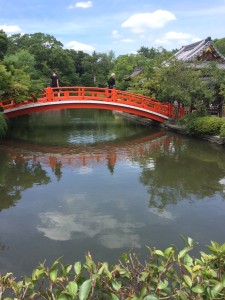
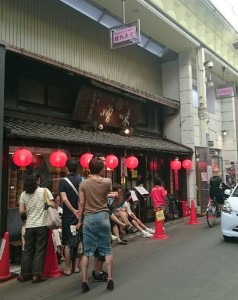
After fieldwork in the surrounding area, the students were divided into teams and continued their fieldwork in Nijo Castle for about 90 minutes. During the fieldwork in the castle, while the information pamphlets are available in multiple languages, many of the signboards installed are only in Japanese, and there were many discoveries and realizations, such as the possibility of conveying the charm of Nijo Castle by making it multilingual, and the usefulness of devising catch phrases that match the historically significant Nijo Castle.
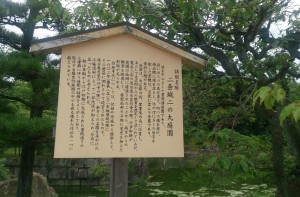
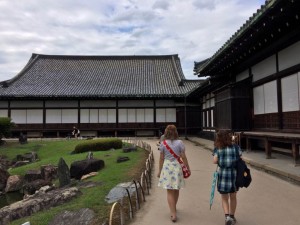
After the fieldwork, we interviewed Tamaki Goto, the head of the Nijo Castle Office of the Kyoto City Culture and Citizenship Bureau. In the interview, questions were asked about the events that have been held at Nijo Castle so far, as well as the restrictions and difficulties due to the fact that it is a cultural property. In addition, there was a lively exchange of opinions on specific proposals, led by students.
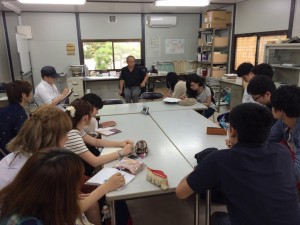
In the future, we will go through voluntary activities during the summer vacation to make our proposals concrete.
Guest lecturer: Lecture by Mr. Ryoichi Kawajiri
Mr. Ryoichi Kawajiri (Ginga Writer / Visiting Professor at Tohoku University of Art and Design) was invited as a guest lecturer to give a lecture on advertising and promotion.
Kyoichi Kawajiri is an editor specializing in advertising creative. Since the theme of Professor Tada’s class is to attract tourists to Nijo Castle and revitalize events through online promotions, he gave a lecture that was very helpful when planning future promotions.
Mr. Kawajiri covers the Cannes Lions International Festival of Creativity, a competition for advertising, communication and promotion, held annually in Cannes, France. This year’s event was held in late June, and we talked about the recent trends in promotion and tips for planning, including the contents of the interview. In the lecture, while introducing the award-winning works of the Cannes Lions, there was also an explanation with specific examples, such as how the O2O method is used in the process.
Mr. Kawajiri also gave important suggestions for future projects, such as the importance of “simple and bold ideas and stories that bring strong empathy” in promotions using O2O, and that “O2O has already been incorporated into daily life (in an “O=O” state), so there is no need to think so hard.
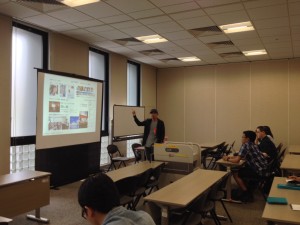
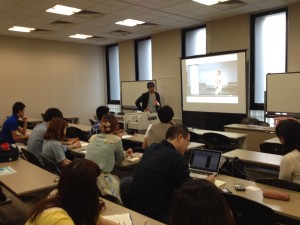
After Mr. Kawajiri’s lecture, the students were divided into groups and shared what they felt and learned in the lecture to deepen their experiences, and each group had a question-and-answer session. During the Q&A session, opinions were exchanged on the pros and cons of using “Yuru Chara”.
In the next class on Sunday, July 12, we will visit Nijo Castle and try fieldwork and interviews.
Learning about Nijo Castle
On Thursday, June 11, a class was held by Professor Tada of Doshisha University, who is developing activities at Nijo Castle. The first class of Mr. Tada’s class was held on Saturday, May 30, at a joint opening ceremony and general orientation with other classes, so this was the first time that he had a class held alone.
The theme of Professor Tada’s class is “creating a ‘device’ for regional revitalization from O2O marketing methods.” O2O is an abbreviation for Online to Offline, which refers to a marketing method that uses online (web) promotions such as social media to direct consumers to physical stores that sell and provide related products and services (offline).
Nijo Castle is in the midst of a full-scale repair project that has spanned 20 years since the castle was built by Tokugawa Ieyasu in 1603, and aims to cover part of the repair costs with donations and profits from various event projects. One of the challenges of this class is to propose how to increase interest in Nijo Castle, increase the number of visitors and participants in various events, and earn revenue to cover repair costs using the O2O method.
In this class, in order to deepen the understanding of Nijo Castle, a lecture was given by Mr. Umebayashi, the head of the former Nijo Castle Office. Mr. Umebayashi introduced the history of Nijo Castle, the cultural properties in the grounds, and the evaluation of Nijo Castle from Japan and abroad, and then explained the “World Heritage Nijo Castle MICE Plan” that Nijo Castle is working on. MICE is an acronym for “Meeting,” “Incentive,” “Convention,” and “Exhibition/Event.” By providing Nijo Castle, a World Heritage Site with high historical value, as a venue for MICE, we aim to widely disseminate the charm of Nijo Castle and Kyoto, as well as the value of cultural properties, and at the same time, earn revenue. He talked about the events he has held so far and the difficulties that arise from the fact that it is a cultural property that arises in holding the event.
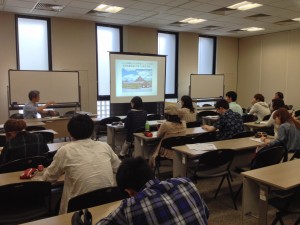
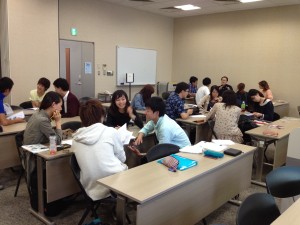
After the lecture, the students were divided into four groups for group work. In addition to deepening the content of the lecture as a group, questions were asked to Mr. Umebayashi and opinions were exchanged on the possibilities of MICE.
















